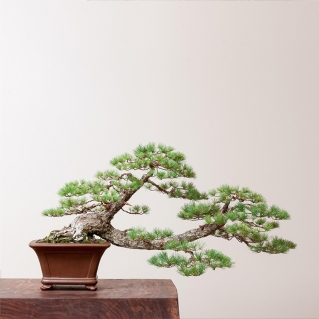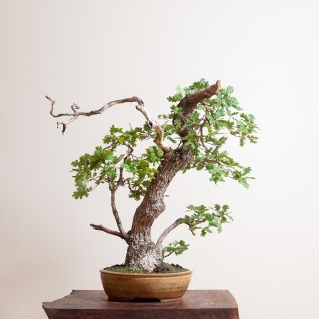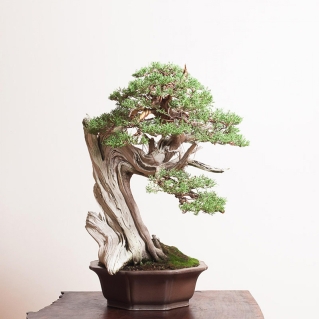Rose Bonsai

General Information
Rose bonsai is a commonly asked-about species. It can be challenging, as rose is an herbaceous, cane-dominated growth perennial rather than a woody perennial. This means that we must have an in-depth understanding of pruning rose plants to be able to use them as bonsai.
One variety that lends itself well to bonsai is the Eijitsu rose multiflora. It is an exquisite dwarf variety of rose that originated in Japan.
This species has:
- A thick and radically-formed woody trunk
- Strong, fine, tight internodes
- Small branches
- Small flowers that create beautiful, tiny orange to reddish-colored rose hips
Overall, rose is underexplored and not fully understood as a bonsai subject—but putting in the work of cultivation and pruning can yield wonderful results.

Caring for Rose Bonsai
Watering
Like many broadleaf species, roses love water. So you should never let the soil fully dry out before watering again. Instead, rewater when the rose bonsai’s soil is on the dry side of damp—but still contains some moisture.
Sun Exposure
Roses love full sun, as this is what allows them to proliferate. They photosynthesize through their stems and their leaf map.
Full sun is what empowers the canes to:
- Have tight inner nodes
- Have smaller leaves
- Become very strong; and
- Build up latent potential buds that can be turned into branching and ramification
Roses do well in full sun up to 90℉. If temps rise any higher, they will need a little shade to get a breather from the scorching afternoon sun.
Temperature
Multiflora roses thrive in warm or hot environments. They enjoy humidity as well, but that comes with its own issues. Although high humidity can prevent problems with insects such as spider mites, it can also facilitate disease more easily.
Roses like temperatures up to 90℉ and can even tolerate temps of over 100℉ if they are protected by a 30% shade cloth.
If you live in a colder environment and are cultivating roses in a shallow container, be careful not to let them free. Rose bonsai are more susceptible to cold when they are in an above-ground container.
Fertilizing
Rose bonsai should be fertilized once a month with solid organic fertilizer. You can also use liquid fertilizer every week during the growing season.
If the leaves turn pale, an extra iron fertilizer can be used.
Pruning
Rose bonsai should be pruned twice a year.
First, pruning should occur before the beginning of growth in the spring. You want to prune back to two nodes on the branching and prune off older, woody pieces that are starting to lose strength. This allows strong green branching to occur.
Over time, the biggest pruning consideration with rose bonsai is to reinvigorate water-conductive green branches while getting rid of older, more lignified growth that doesn’t conduct water well anymore.
A rose bonsai’s second pruning should be done right after the rose hips start to dry up and fall off—after flowering. This usually occurs mid-summer. This final prune both holds the shape of the tree and invigorates it with another spurt of growth. This allows the rose to go into the vascular formation phase of fall with higher water conductivity.
Wiring
Young rose bonsai branches are easy to wire—but watch out for sharp thorns! Older branches are usually brittle and stiff, so be extra careful when wiring and positioning them.
Repotting
Rose bonsai should be repotted as the buds start to swell in the spring. Use up to ¼ inch of solid akadama soil as your interior size. Once you have an established root system, be careful not to bare the root when repotting.
Propagation
Rose bonsai may be propagated from summer cuttings. Look for shoots that are about one year old and have hardened well. You may also be able to propagate by air layering.
Pests/Disease
The pest you must look out for with rose bonsai is the spider mite, especially if you live in an area with low relative humidity. Spider mites love to feed on rose bonsai stems and leaf rows.
A spider mite infestation often directly correlates to an overly aggressive fertilizer schedule and too much nitrogen. Rose bonsai should be fed with a moderate, or even light, application of fertilizer so as not to invite spider mites onto the plant.
A common disease for rose bonsai is powdery mildew. This occurs when the leaf mass is kept too wet and has poor air circulation, or if there is high relative humidity and a dense canopy.
Avoid watering the foliage of the tree to keep it from getting powdery mildew.
Rose Bonsai FAQS
Yes! Any tree or shrub can be a bonsai.
Rose is a shrub that has unique pruning habits. To perpetuate branching quality, you must replace aging branches with young, fleshy shoots.
This means you should constantly rebuild the branching of the rose when cultivating it as a bonsai in a shallow, confined environment.
It’s not hard, as roses are naturally built to flower. However, be sure not to prune once the rose starts to produce foliar mass.
Pruning should be done before the push of foliage, pruning back to two buds and replacing older branches with younger ones.
This allows free growth throughout the summer, which is how rose plants can dependably flower and produce a beautiful display.
Absolutely! Any tree or shrub living in the shallow, confined environment of a bonsai container can be overwatered.
Although roses love moisture, giving them too much water is possible if you aren’t careful.
Once your rose bonsai flowers, the only way to protect it from deer and other critters that want to eat it is to put it behind a fence or put a cage around it.
Some people may think this spoils the aesthetic of their garden design—but so does a denuded rose bonsai!
If you’re going to dedicate the time and attention to cultivating rose bonsai, you should think about where the tree can be placed to maximize its enjoyment and protection.




